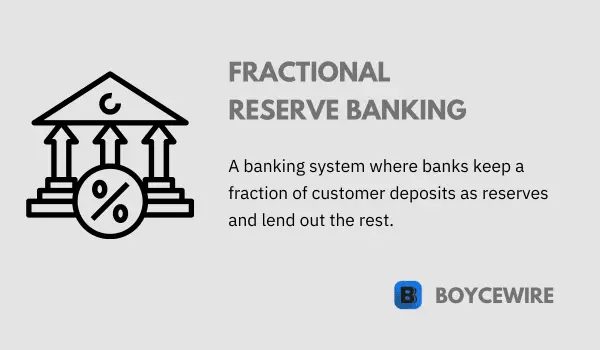Fractional Reserve Banking: Definition, Pros, Cons & Examples

What is Fractional Reserve Banking?
Fractional reserve banking is a cornerstone of modern banking systems, playing a vital role in economies worldwide. This banking system allows banks to keep a fraction of deposits as reserves and lend out the rest, stimulating economic growth by creating credit and expanding the money supply. It involves a delicate balance of promoting economic activity while managing the inherent risks.
In this system, only a portion of bank deposits are backed by actual cash on hand and available for withdrawal. This is possible because banks expect that not all customers will demand their cash at once. While it might seem precarious, fractional reserve banking is largely stable and has regulatory safeguards in place to mitigate potential risks, such as “bank runs,” where a large number of customers withdraw their deposits simultaneously.
Key Points
- Fractional reserve banking is a system where banks are required to hold only a fraction of their deposits as reserves, allowing them to lend out the majority of the funds.
- The reserve requirement is determined by central banks and serves as a way to control the money supply and influence economic activity.
- Banks create new money through the process of lending, as loans create deposits that can be used for further lending.
Understanding Fractional Reserve Banking
Fractional reserve banking is a banking system where banks keep only a fraction of their depositors’ balances in reserve and lend out the rest. This system serves as the basis for most modern banking systems and is essential for facilitating economic growth and stability.
To understand how this works, consider a simple example. Suppose a customer deposits $1,000 into their bank account. In a fractional reserve banking system, the bank is only required to hold a fraction of this deposit, say 10% or $100, as reserves. The remaining $900 can be lent out to other customers as loans.
When the bank makes a loan, it creates new money. This is because the original depositor still has a claim to their $1,000 deposit, and the borrower now has access to the $900 loan. In essence, the bank has created $900 of new money that did not exist before.
This process can be repeated multiple times, leading to a multiplication of the total amount of money in the economy. For instance, if the borrower deposits their $900 loan into their own bank account, their bank can then hold 10% of this deposit ($90) in reserve and lend out the remaining $810, and so on. This is often referred to as the money multiplier effect.
However, there is a limit to how much money can be created in this way. This limit is determined by the reserve requirement, which is the fraction of deposits that banks are required to keep in reserve. In the above example, the reserve requirement was 10%, but this rate is typically set by the country’s central bank and can vary depending on the country and the type of deposit.
In essence, fractional reserve banking is a balancing act. On one hand, banks need to keep enough reserves to satisfy customer withdrawals and meet the reserve requirement. On the other hand, they want to lend as much as possible to earn interest and facilitate economic activity. As such, the success and stability of a fractional reserve banking system relies heavily on customer confidence and prudent regulation by the central bank.
Benefits of Fractional Reserve Banking
Fractional reserve banking, despite its complexities and potential risks, offers a number of benefits that have led to its widespread adoption as the predominant system of banking worldwide.
1. Expansion of the Money Supply
Fractional reserve banking allows for the expansion of the money supply. When banks lend out a portion of the deposits they receive, they effectively create new money. This increased supply of money can stimulate economic activity and growth.
2. Liquidity Provision
Fractional reserve banking provides liquidity to the economy. By keeping only a fraction of deposits on hand, and lending out the rest, banks can meet the day-to-day transaction needs of their customers while also providing loans to businesses and individuals who need them.
3. Interest Earnings for Depositors
Because banks are able to earn income by lending out deposits, they can offer interest on the money customers deposit with them. This encourages saving and provides income to depositors.
4. Financial Intermediation
Banks serve as financial intermediaries, connecting those with surplus funds (depositors) to those in need of funds (borrowers). This supports investment and can help drive economic growth.
5. Monetary Policy Control
The fractional reserve system allows central banks to control monetary policy. By adjusting the reserve requirement – the amount of deposits banks are required to keep in reserve – central banks can influence the amount of money that banks can create through lending, thus influencing overall economic activity.
6. Risk Diversification
By lending to a variety of borrowers, banks can diversify risk. If one borrower defaults on a loan, the impact on the bank is limited by the fact that it has many other loans outstanding.
Disadvantages of Fractional Reserve Banking
While fractional reserve banking has benefits that contribute to economic growth and financial stability, it also comes with a number of disadvantages and inherent risks.
1. Risk of Bank Runs
The most commonly cited risk of fractional reserve banking is the risk of a bank run. This occurs when a large number of depositors, fearing for the safety of their deposits, simultaneously withdraw their money. Since the bank only keeps a fraction of total deposits on hand, it may not be able to fulfill all withdrawal requests, leading to insolvency.
2. Inflation Risk
The ability of banks to create money by lending more than their reserves can lead to inflation. If the supply of money grows too quickly in relation to the goods and services available for purchase, the general level of prices can rise.
3. Excessive Risk-Taking
Fractional reserve banking can also encourage excessive risk-taking by banks, known as moral hazard. Because deposits are often insured by the government, banks might take on riskier loans than they would otherwise, knowing that they’ll be covered if those loans default.
4. Financial Instability
The credit creation process in fractional reserve banking can contribute to financial instability and business cycles. If new loans are used for speculative investment, such as real estate, it can lead to price bubbles. When the bubbles burst, it can result in a contraction in credit (a credit crunch), potentially triggering a recession.
5. Wealth Inequality
Fractional reserve banking can potentially contribute to wealth inequality. Those with more wealth have greater access to credit and can thus benefit more from the system, while those with less wealth have less access to credit.
6. Dependence on Central Bank Policies
Banks under this system are heavily dependent on the monetary policies of central banks. Changes in the reserve requirement or interest rate can greatly affect the banking industry’s ability to lend and create money.
Examples of Fractional Reserve Banking
Practically every commercial bank in the world operates on the fractional reserve banking system. Here are some illustrative examples to better understand this banking practice:
- Basic Banking Example Consider a scenario where a customer deposits $1,000 into a bank. Assuming the reserve requirement is 10%, the bank sets aside $100 and lends out the remaining $900 to another customer. That customer spends the $900 at a shop, and the shopkeeper deposits that money into their bank account. The bank then sets aside 10% ($90) of this new deposit and lends out the rest ($810). This process can continue, each time with the bank lending out less money as it adheres to the reserve requirement. Through this process, the original deposit of $1,000 can create a much larger total amount of money in the economy.
- U.S. Banking and the Federal Reserve The Federal Reserve, the central bank of the United States, requires depository institutions to hold a certain percentage of their deposits as reserves. This percentage depends on the total amount of a bank’s deposits, with larger banks generally required to hold a greater percentage of their deposits in reserve.
- Canadian Banking and No Reserve Requirements An interesting counterexample is the banking system in Canada. The Bank of Canada, Canada’s central bank, does not require banks to hold any percentage of their deposits in reserve. Despite this, Canadian banks do hold reserves as a matter of prudent banking practice. This system has functioned without any major issues, demonstrating that it’s possible for a fractional reserve banking system to function without a formal reserve requirement.
- Banking During the 2008 Financial Crisis During the financial crisis of 2008, the concept of fractional reserve banking became a hot topic as some banks found themselves with inadequate reserves when the value of their assets (particularly mortgage-backed securities) fell dramatically. In response, central banks around the world took steps to support the banking system, including reducing reserve requirements and providing additional liquidity to banks.
These examples highlight the various ways fractional reserve banking operates in different contexts, the influence of central banks, and the potential vulnerabilities of this system.
Fractional Reserve Banking and Monetary Policy
Fractional reserve banking plays a critical role in the implementation of monetary policy. Central banks use monetary policy as a tool to manage inflation, stabilize the economy, and control the money supply. In a fractional reserve banking system, central banks implement monetary policy through several mechanisms:
- Reserve Requirements Central banks can directly influence the amount of money created in the banking system by setting the reserve requirement – the portion of deposits that banks are required to keep in reserve and not lend out. A higher reserve requirement reduces the amount of money a bank can lend, effectively decreasing the money supply and vice versa.
- Interest Rates Central banks can influence the interest rates charged by commercial banks. By adjusting the interest rate at which banks can borrow funds from the central bank (the discount rate), they can influence the cost of credit and the amount of lending in the economy. A lower interest rate encourages more lending (and thus more money creation), while a higher rate has the opposite effect.
- Open Market Operations Central banks can also directly control the money supply through buying and selling government securities in open market operations. When a central bank purchases securities, it pays with money that it essentially creates out of thin air, increasing the reserves of banks and allowing them to lend more. Conversely, selling securities reduces the reserves of the banks, reducing their ability to lend.
- Quantitative Easing This is an unconventional monetary policy used by central banks when standard methods become ineffective. Central banks buy long-term securities from the open market in order to increase the money supply and encourage lending and investment.
In this way, fractional reserve banking provides central banks with the ability to manage economic cycles, control inflation, and stabilize the financial system. However, the effectiveness of these tools can vary depending on various factors, including the timing and magnitude of the changes, the expectations of consumers and businesses, and overall economic conditions. It is a delicate balancing act requiring careful analysis and judgment by the monetary authorities.
FAQs
Fractional reserve banking is a system where banks are only required to hold a fraction of their deposits as reserves, allowing them to lend out the majority of the funds.
Banks accept deposits from customers and keep a portion of those deposits as reserves, which are typically held in the form of cash or deposits with the central bank. The remaining funds are available for lending to individuals and businesses.
Fractional reserve banking allows banks to create credit and expand the money supply, supporting economic activity and investment.
Reserve requirements are regulations set by central banks that determine the minimum amount of reserves that banks must hold against their deposits.
About Paul
Paul Boyce is an economics editor with over 10 years experience in the industry. Currently working as a consultant within the financial services sector, Paul is the CEO and chief editor of BoyceWire. He has written publications for FEE, the Mises Institute, and many others.

Further Reading
 Checks and Balances - Checks and balances is a system that prevents the concentration of power by distributing and restraining the authority among different…
Checks and Balances - Checks and balances is a system that prevents the concentration of power by distributing and restraining the authority among different…  Business Ethics - Business ethics refers to the moral principles and values that guide the behavior and decision-making of individuals and organizations in…
Business Ethics - Business ethics refers to the moral principles and values that guide the behavior and decision-making of individuals and organizations in…  Marginal Utility: Definition, Formula & Example - Marginal Utility is the enjoyment or satisfaction that a consumer gains for each additional unit they consume. So it calculates…
Marginal Utility: Definition, Formula & Example - Marginal Utility is the enjoyment or satisfaction that a consumer gains for each additional unit they consume. So it calculates… 